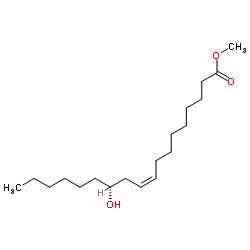RICINOLEIC ACID, METHYL ESTER

RICINOLEIC ACID, METHYL ESTER structure
|
Common Name | RICINOLEIC ACID, METHYL ESTER | ||
|---|---|---|---|---|
| CAS Number | 141-24-2 | Molecular Weight | 312.487 | |
| Density | 0.9±0.1 g/cm3 | Boiling Point | 412.0±28.0 °C at 760 mmHg | |
| Molecular Formula | C19H36O3 | Melting Point | -29ºC | |
| MSDS | Chinese USA | Flash Point | 154.6±16.8 °C | |
|
Preparation and properties of gem-dichlorocyclopropane derivatives of long-chain fatty esters.
Lipids 27(1) , 59-64, (1992) Methyl oleate (18:1) and linoleate (18:2) were readily transformed to the corresponding gem-dichlorocyclopropane derivatives in high yield, using triethylbenzylammonium chloride as the phase-transfer catalyst in the presence of aqueous NaOH and CHCl3. Reactio... |
|
|
Metabolism of fatty acid in yeast: characterisation of beta-oxidation and ultrastructural changes in the genus Sporidiobolus sp. cultivated on ricinoleic acid methyl ester.
FEMS Microbiol. Lett. 250(1) , 63-9, (2005) Cell structure modifications and beta-oxidation induction were monitored in two strains of Sporidiobolus, Sp. Ruinenii and Sp. pararoseus after cultivation on ricinoleic acid methyl ester. Ultrastructural observations of the yeast before and after cultivation... |
|
|
Medium-size droplets of methyl ricinoleate are reduced by cell-surface activity in the gamma-decalactone production by Yarrowia lipolytica.
Lett. Appl. Microbiol. 30(3) , 183-7, (2000) Size of methyl ricinoleate droplets during biotransformation into gamma-decalactone by Yarrowia lipolytica was measured in both homogenized and non-homogenized media. In non-homogenized but shaken medium, droplets had an average volume surface diameter d32 of... |
|
|
Surface properties of Yarrowia lipolytica and their relevance to gamma-decalactone formation from methyl ricinoleate.
Biotechnol. Lett. 27(6) , 417-22, (2005) The surface of the lipid-degrading yeast, Yarrowia lipolytica, was characterized by contact angle and zeta potential (zeta) measurements. The cells were mainly hydrophilic with a negative charge that was only affected from pH 2 to 4. To study the effects of t... |
|
|
Bioconversion of methyl ricinoleate to 4-hydroxy-decanoic acid and to gamma-decalactone by yeasts of the genus Candida.
J. Basic Microbiol. 35(5) , 285-92, (1995) The capacity of several strains of yeasts to do the bioconversion of methyl ricinoleate into gamma-decalactone, was studied in a medium containing this methylic ester of fatty acid as sole carbon source. Amongst the strains which are able to do this bioconver... |
|
|
Oil-in-water emulsions characterization by laser granulometry and impact on γ-decalactone production in Yarrowia lipolytica.
Biotechnol. Lett. 33(8) , 1601-6, (2011) Oil-in-water emulsions composed of methyl ricinoleate (MR) or castor oil (CO) as the organic phase, stabilized by Tween 80, are in the basis of the biotechnological production of γ-decalactone. Yarrowia lipolytica was used due to its ability to grow on hydrop... |
|
|
Ultrasound in fatty acid chemistry: synthesis of a 1-pyrroline fatty acid ester isomer from methyl ricinoleate.
Lipids 29(12) , 889-92, (1994) A novel 1-pyrroline fatty acid ester isomer (viz. 8-5-hexyl-1-pyrrolin-2-yl) octanoate) has been synthesized from methyl ricinoleate by two routes with an overall yield of 42 and 30%, respectively. Most of the reactions are carried out under concomitant ultra... |
|
|
Increased electron donor and electron acceptor characters enhance the adhesion between oil droplets and cells of Yarrowia lipolytica as evaluated by a new cytometric assay.
J. Agric. Food Chem. 51(10) , 3007-11, (2003) The adhesion of methyl ricinoleate droplets to cells of the yeast Yarrowia lipolytica was investigated. A new cytometric method, relying on the double staining of fatty globules with Nile Red and of cells with Calcofluor, enabled us to quantify methyl ricinol... |
|
|
Catabolism of hydroxyacids and biotechnological production of lactones by Yarrowia lipolytica.
Appl. Microbiol. Biotechnol. 61(5-6) , 393-404, (2003) The gamma- and delta-lactones of less than 12 carbons constitute a group of compounds of great interest to the flavour industry. It is possible to produce some of these lactones through biotechnology. For instance, gamma-decalactone can be obtained by biotran... |
|
|
Role of beta-oxidation enzymes in gamma-decalactone production by the yeast Yarrowia lipolytica.
Appl. Environ. Microbiol. 67(12) , 5700-4, (2001) Some microorganisms can transform methyl ricinoleate into gamma-decalactone, a valuable aroma compound, but yields of the bioconversion are low due to (i) incomplete conversion of ricinoleate (C(18)) to the C(10) precursor of gamma-decalactone, (ii) accumulat... |